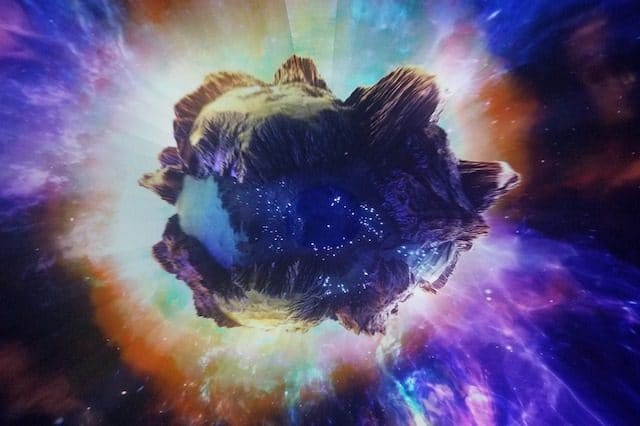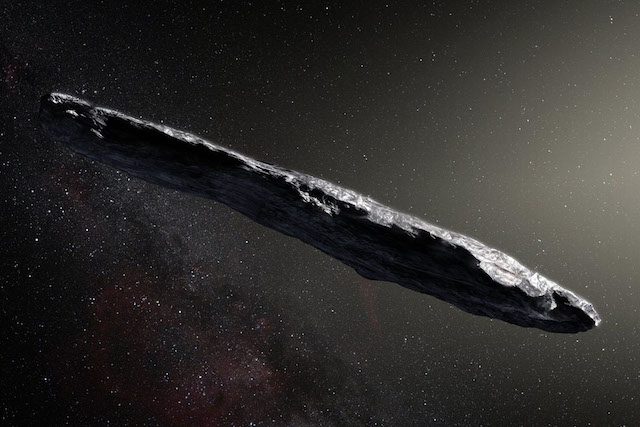Comets and asteroids come and go, but few make as much of a stir as ‘Oumuamua. Toward the end of last year, its virtually unprecedented appearance from interstellar space made urgent headlines around the world. And, in various ways, it left an indelible footprint.
While numerous mysteries remain about this curious galactic traveller, astronomers managed to glean several key pieces of information during its recent fly-by. Here are some of the most interesting.
10. It Probably Isn’t Alien Technology
The discovery of ‘Oumuamua was oddly coincidental with last year’s revelations about the Pentagon’s secret black money UFO program. And indeed the first thought among even seasoned astronomers like Stephen Hawking was that it could be an alien starship, or at least an artifact from some extraterrestrial civilization.
With the backing of Hawking (as well as Mark Zuckerberg and Yuri Milner) the Breakthrough Listen initiative set out to detect signs of intelligence from the object, specifically listening for artificial radio signals. And while at the time of writing they hadn’t found any, the team accumulated a massive 90 terabytes of raw data across billions of individual channels, so a full analysis (including pulsating signals as well as continuous) may take some time. That said, another research team carried out spectroscopic observations and concluded that the object is natural.
Nevertheless, the spot-on timing of ‘Oumuamua’s discovery (and the inevitable comingling of media coverage) has fueled a “false flag” conspiracy theory that the military-industrial complex is preparing us for a staged alien invasion. Such a bigger, badder menace, it is feared, could potentially clear the way for unlimited military spending and harsher civil restrictions.
9. It’s Seen as a “Messenger from Afar”

Officially designated 1I/2017 U1 by the International Astronomical Union—the first of a brand new class—the object’s unofficial (but for some equally unwieldy) nickname ‘Oumuamua was given by the Pan-STARRS team that discovered it.
Pronounced oh-MOO-uh MOO-uh, the word is Hawaiian for “messenger from afar arriving first,” and it’s particularly apt considering the potentially breakthrough data the object carries about the formation of other solar systems.
Assuming it doesn’t turn out to be artificial (and even, or especially, if it does!), there’s a lot more we can learn from it too, including the long-term effects of exposure to cosmic rays. Astronomers studying the origins of ‘Oumuamua have been especially poetic in their appraisal, describing the object as a “messenger sent from the distant past to reach out to us.”
8. It’s Among the Fastest Objects Ever Detected

One of the most surprising things about ‘Oumuamua was its incredible speed. The average asteroid travels at 25 km/s and the average comet at 40 km/s relative to the Earth. But when ‘Oumuamua was discovered in October 2017, it was going an impressive 60 km/s relative to the Earth and only picking up speed as it approached the Sun.
At its fastest, just as it slingshot around the star, it reached a blinding 87.3 km/s, or 196,000 miles per hour (315,431 km/h) relative to the Sun, which kept it from falling in completely and burning up for good.
Although ‘Oumuamua lost speed considerably as it climbed away, owing to the intense gravitational pull of the Sun, it maintains a velocity of around 26 km/s (93,600 km/h) as it flies along its new trajectory.
7. It’s Pink

Although a great deal of media attention has focused on the reddish hue of ‘Oumuamua, it’s not actually all that remarkable—and it’s not actually all that red.
Outside of a star’s magnetic field, drifting through interstellar space, objects like ‘Oumuamua are continually exposed to high-energy radiation from cosmic rays. And, as is well known among astronomers, this continual bombardment substantially alters surface properties over time. In fact, the process of color change is so reliable that the redness of an object can be used to gauge, approximately, how long it’s been floating in space.
Since ‘Oumuamua is pinkish in color it’s unlikely to have been wandering for the billions of years that some have suggested (and for which our solar system has existed). Instead, its relatively neutral color suggests exposure for hundreds of millions of years at the most, a “relatively young” age when it comes to celestial driftwood.
6. It’s Not Really the First Interstellar Visitor

Another media focus has been the rarity of interstellar objects in our solar system, with many claiming that ‘Oumuamua is in fact the first. It’s certainly interesting to note that none of the 750,000 or so asteroids and comets within our solar system are thought to have come from outside it—even though planet formation ejects plenty of material into interstellar space.
That said, ‘Oumuamua is extremely unlikely to be the first interstellar object to visit. There are estimated to be more than 46 million such objects crossing our solar system each year, most of which are just too far away to be seen. It is, however, the first detectable object known to be interstellar in origin. And we know this because of its hyperbolic trajectory (a trajectory outside of any central body’s gravitational pull) and its speed at infinity (a velocity higher than escape velocity, the minimum speed required to escape a massive body’s gravitational pull).
That we haven’t seen more of these is really just a limitation of our technology; we were lucky to catch even this one. As more advanced telescopes come online, astronomers expect to see plenty more interstellar objects flying through our solar system. Among other things, this means more opportunities for research and more potential targets for extraterrestrial life.
5. It Defies Categorization

When it was discovered by the University of Hawaii’s Pan-STARRS1 telescope, ‘Oumuamua was thought to be a comet. But it had more rock than ice and, although it heated up when it passed the Sun—reaching a surface temperature of 550 degrees Fahrenheit—no surface ice boiled off and no tail developed.
But it’s not an asteroid either; researchers found no signs of the usual minerals, speculating instead that ‘Oumuamua consists of a robust carbon casing around an icy core—frozen alien water shielded for hundreds of millions of years and unable to boil off in starlight. In other words, says astronomer Alan Fitzsimmons of Queen’s University Belfast, it looks like an asteroid but it’s built like a comet—albeit one that’s turned inside out. Even this theory has been thrown into question more recently, though, since there’s no evidence of water either.
For now, ‘Oumuamua is simply referred to as an “interstellar object,” or sometimes more romantically as a sola lapis or “lonely rock.”
4. It Looks Like a Cigar (or a Needle, or an Oddly Shaped Pen, or Maybe Even a Monolith from 2001)

Widely circulated images like the one above are of course artists’ impressions. Nobody’s seen ‘Oumuamua up close. So the question arises: How do we know what it looks like?
The truth is we don’t—not exactly. All we know is that it’s around ten times as long as it is wide, and we base this on observations of light. As the object spins on its axis (once every 7.3 hours or so), huge fluctuations in brightness suggest a greater aspect ratio than anything seen before—comet or asteroid. Imagine a shiny cylinder spinning toward a light in slow motion; you’d see relatively little light reflected from the ends but, as it rotated, substantially more from the sides. Even if you didn’t know the shape, you’d be able to guess the dimensions.
As such, ‘Oumuamua is thought to be around 400 meters (or one quarter mile) in length and just 40 meters wide, although some estimates put it at 800×80 meters or even 160 meters in width. Whatever the case, the shape is certainly weird, and this could give us clues as to how other solar systems form.
3. We May Never Know Where It Came From

There are various theories as to the origins of ‘Oumuamua, but none can be taken as fact. According to one theory, it could be from the Kuiper Belt or Oort Cloud and not interstellar at all. In this case, its speed would suggest the presence of an as yet undiscovered planet whose gravity would be required to boost it.
In earlier simulations, ‘Oumuamua’s trajectory was tracked back to the bright star Vega in the constellation of Lyra; however, because it would have taken 300,000 years to reach us (even at such speeds), Vega wouldn’t have been in the same position when ‘Oumuamua is supposed to have left.
Wherever the object originated, it’s likely to have been ejected from the debris surrounding a young star (also known as the protoplanetary disk)—perhaps in the Pleiades—hundreds of millions of years ago.
It may now be part of an immense interstellar asteroid field, through which our Sun and its satellites are currently cruising on our journey around the Milky Way’s core. There are estimated to be around 700 trillion such objects per cubic parsec, which is pretty dense considering a parsec is equivalent to just 30 trillion kilometers. Based on these figures, anywhere between 2 and 12 interstellar objects should be passing through the solar system, inside Earth’s orbit, every year.
2. It’s Leaving Us, But It’ll Take Some Time

‘Oumuamua is now on its way out of the solar system, headed back out to the stars at a rate of 26 km/s. But even at that speed, it’ll take 20,000 years for it to leave our solar system entirely.
Meanwhile, it’s becoming increasingly difficult (if it’s not yet impossible) to observe ‘Oumuamua with existing telescopes—an especially unfortunate situation given its rarity. Understandably, astronomers are clamouring for a closer look, and sending a probe to the object—however far-fetched that sounds—is one of their highest priorities.
Of course, that means chasing ‘Oumuamua down and intercepting it at speeds higher than 26 km/s, which isn’t really plausible given current technology. Even Voyager 1, the fastest object ever launched, can only reach 16.6 km/s.
The longer we leave it, though, the faster we’ll need to go to catch up within a reasonable timeframe, that is, before ‘Oumuamua travels too far out for our probe to return data to Earth.
Laser propulsion—whereby ultra-light, wafer-thin craft are propelled to within 25 percent of the speed of light by multi-megawatt lasers in orbit—could hold promise, but the technology is nowhere near ready. As such, some astronomers are banking instead on laser sails being available in time for the next interstellar arrival.
1. It Shows Us How Unprepared We Are for Possible Asteroid Impacts

One of the things ‘Oumuamua can teach us is how to better detect near-Earth and potentially hazardous objects. But its sudden appearance to our telescopes is a bit of a wake up call. Were ‘Oumuamua’s trajectory headed toward Earth, it would have hit us before we’d even seen it.
The worst case scenario, according to amateur researchers, would have been the leveling of an entire city with a force equivalent to 2,057 Hiroshima bombs. Entering the atmosphere at 233 times the speed of sound, ‘Oumuamua could have vaporized everything within at least a 50 kilometer (30 mile) radius of ground zero, killing hundreds of thousands or even millions of people.
Bigger, more sophisticated telescopes—such as the Large Synoptic Survey Telescope currently under construction in Chile—will no doubt help us to better detect objects in the future. But, for now at least, ‘Oumuamua highlights a worrying vulnerability to space rocks—especially considering the Pan-STARRS telescope that discovered it (after it passed by) is specifically tasked with our protection.